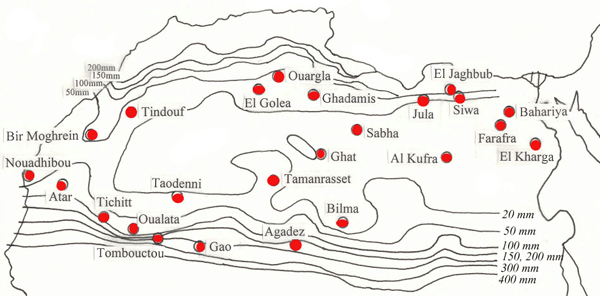Deserts and Oases
First, we're going to visit the modern Sahara desert, and then explore the long-term changes in climate that caused it to form. We'll spend a great deal of time worrying about the Sahara desert, and this image is a good place to start. The Sahara today receives less than 2 inches of rain each year. Yet it is home to over 4 million people, who spend all or a large part of their lives within the desert, tending camels, goats, sheep and sometimes cattle. Some desert peoples mine salt as well, and transport it across trans-Saharan trade routes that go back thousands of years.
So - how do people live in the desert?
They need water. There are oases scattered throughout the desert, and though their quality and appearance varies tremendously, they provide the bulk of water for people and animals in this region. This particular oasis is a small clear pond in an area of low topography. Others, as we will see, are formed in and around ancient rivers that no longer flow.

Desert dunes with camels and Oasis. Source: National Geographic
Most of the romanticized cities in West Africa are in fact Sahelian oases: Timbuktu (Tombouctou), Agadez, Bilma, Bamako, Tamanrasset, and many others. The water in these oases has been dated in many places, and it is generally between 20,000-30,000 years old. That is, the water people drink today in places like Libya, Algeria, Tunisia, and throughout the Sahara is incredibly old. It represents rain that fell in such great quantities that it seeped into the soil and then deeper into porous bed rock, and has stayed there for tens of thousands of years. It represents a very obvious non-renewable resource.
As you can see on the map, the oases are located in places where the modern rainfall is clearly insufficient to provide adequate drinking water. So we must be talking about climate change. There was a time when the Sahara was immensely rainy, and now it is not. We care because the development of Egyptian civilization and settlement in the Nile Delta was driven by this climate change. We also care because this huge change in climate was not caused by human activity.

Saharan oases and rainfall. Source: Barbara Tewksbury, Hamilton College